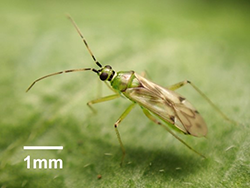The National Agriculture and Food Research Organization (NARO) and the University of Miyazaki have revealed that the symbiotic bacterium Rickettsia, which widely infects Nesidiocoris tenuis—a natural enemy of agricultural pests such as whiteflies and thrips—affects the reproduction of N. tenuis by increasing the number of offspring from infected female. This finding demonstrates that the infection status of symbiotic bacteria is important for the efficient proliferation of N. tenuis. Optimizing the reproductive potential of N. tenuis through symbiotic bacteria could pave the way for improved biological control strategies using natural enemies.
Overview
Many insects are naturally infected with symbiotic bacteria that are transmitted vertically from mother to offspring but are not transmitted horizontally. Understanding the effects of these symbionts is important in terms of insect pest management as they can significantly affect the biology and reproduction of insects. The predatory mirid bug, Nesidiocoris tenuis (Figure 1), which preys on agricultural pests such as whiteflies and thrips, is an important biological control agent. Although the symbiotic bacterium Rickettsia is often found in N. tenuis, its effects on the host have not been clarified.
NARO and the University of Miyazaki have revealed that Rickettsia induces strong cytoplasmic incompatibility (CI) in N. tenuis. CI is a phenomenon where eggs laid by uninfected females fail to hatch when mated with infected males (Figure 2). In this study, mating experiments using Rickettsia-infected insects and antibiotic-treated uninfected insects demonstrated that eggs did not hatch, specifically in the combination of CI. This suggests that infected females can produce offspring regardless of whether they mate with infected or uninfected males, giving them a reproductive advantage over uninfected females.
This discovery has significant implications for biological control which involves the reproduction of predatory insects that are used for pest management. When using predatory insects for pest control, it is crucial to maintain sufficient numbers of these insects in agricultural fields. This research demonstrates that N. tenuis infected with Rickettsia have a significant advantage in efficient reproduction at a laboratory level. Future studies will aim to confirm the reproductive efficiency and pest control ability of Rickettsia-infected N. tenuis in agricultural fields. This could lead to the development of more effective pest control methods using natural enemies through enhancing their reproduction, thereby reducing the reliance on chemical pesticides and contributing to the realization of "zero pest damage" agriculture.
Budget:
This work was supported by the Cabinet Office, Government of Japan, Moonshot Research and Development Program for Agriculture, Forestry and Fisheries (grant number JPJ009237).

Figure 1. Nesidiocoris tenuis

Figure 2. Cross combinations between infected and uninfected insects
Publication
Owashi Y, Arai H, Adachi-Hagimori T, Kageyama D (2024) Rickettsia induces strong cytoplasmic incompatibility in a predatory insect. Proceedings of the Royal Society B 291: 20240680. https://doi.org/10.1098/rspb.2024.0680
For Inquiries
Contact: https://www.naro.go.jp/english/inquiry/index.html




